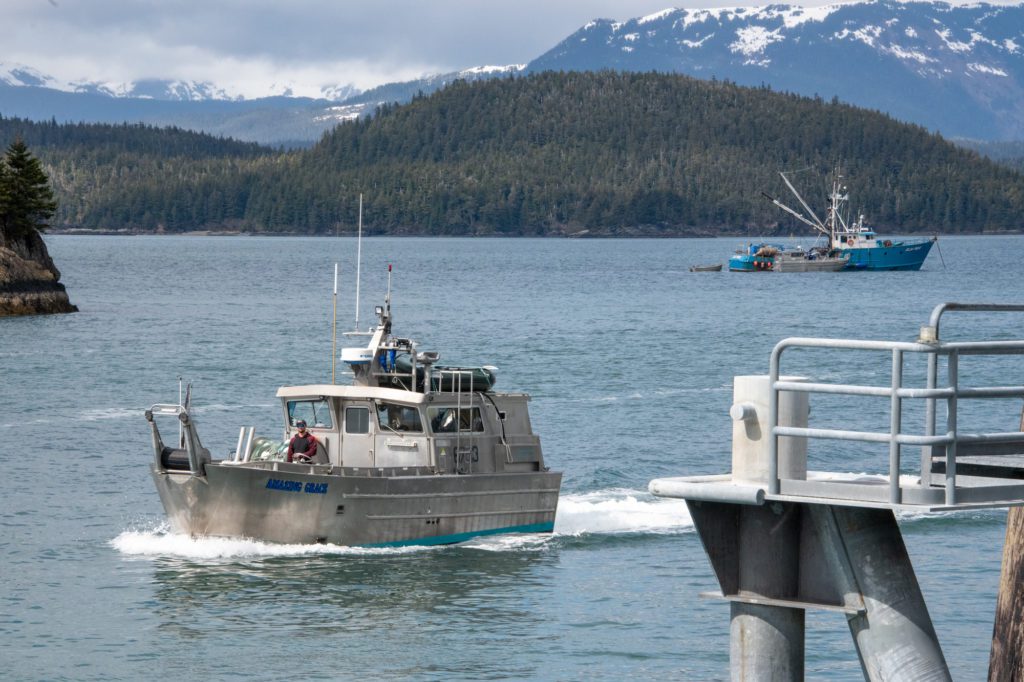
Commercial salmon harvest numbers in Prince William Sound climbed to 8.3 million fish by Wednesday, July 14, as the overall statewide harvest surged to nearly 55 million fish.
Alaska Department of Fish and Game preliminary harvest figures show harvesters in Prince William Sound have delivered some 5.8 million humpies, 1.8 million chum, 706,719 sockeye, 8,078 Chinook and 1,026 coho salmon to processors.
While the Copper River sockeye harvest, at some 295,268 fish, remains below forecast, the enhanced run of chums in the Coghill district, with a drift gillnet harvest now exceeding 1.1 million fish, is coming in better than anticipated, said Jeremy Botz, gillnet area management biologist for ADF&G in Cordova.
Fishermen in the Coghill district also have caught an estimated 150,357 sockeye, over 79,000 pink, 466 Chinook and 96 coho salmon, while the Copper River drift gillnetters have delivered over 295,000 sockeye, 8,132 chum, 6,889 Chinook, 1,588 pink and 534 coho salmon.
Drift gillnetters and setnetters in the Eshamy Main Bay district showed a harvest of 213,835 sockeyes and 128,399 chum, plus smaller numbers of pink, Chinook and coho salmon.
Purse seiners in the Prince William Sound Eastern district brought in 4.8 million pink, 7,802 chum and nearly 5,000 sockeyes, while in the Prince William Sound northern district the purse seine catch included 609,004 humpies, 1,049 chum and 439 sockeyes.
The Prince William Sound southwestern purse seine district had 273,634 chum and 32,441 sockeyes, plus nearly 6,200 pink salmon, and the Montague purse seiners delivered 373,951 pink, 288,881 chum and 3,426 sockeyes, plus 377 Chinook and 142 coho salmon.
The overall statewide preliminary commercial harvest rose to 54.7 million fish, including nearly 41 million sockeyes, nearly 10 million pink, 3.7 million chum, 107,000 Chinook and 56,000 coho.
For Bristol Bay alone, the sockeye harvest jumped to 33.6 million fish, with the largest deliveries, of 16.5 million sockeyes, from the Nushagak district. The sockeye harvest climbed to 6.9 million and 6.8 million in the Naknek-Kvichak and Egegik districts respectively, and the Ugashik district brought in another over 3 million sockeyes, the latest ADF&G preliminary harvest report said.
Harvests remained low for the Cook Inlet region and in the Arctic-Yukon-Kuskokwim region of western Alaska the only deliveries were some 2,000 chum from the Kotzebue area. The only deliveries were some 2,000 chum from the Kotzebue area. There have been no commercial fishing periods on the Yukon due to low salmon runs, while harvests continue to rise in the westward region for the Alaska Peninsula and Kodiak area.
The South Peninsula has delivered 7.4 million salmon to processors, including 3.4 million pink, over 3 million sockeye and 909,000 chum salmon.
For the Kodiak region deliveries have reached 1.4 million fish, including over 1 million sockeyes, 278,000 pink and 105,000 chum salmon.
As Alaska’s early season fisheries of Chinook sockeye and keta salmon reach the approximate midpoint of their season the pace of fishing has slowed slightly compared to last year, said Dan Lesh, who produces in-season commercial salmon reports for McKinley Research Group in Anchorage on behalf of the Alaska Seafood Marketing Institute.
Lesh said this year’s salmon harvest so far is about 87% of the projected Alaska salmon harvest at this point last year (2019 for pink salmon) down from 96% last week.
So far this year 23% of the projected Alaska salmon harvest of some 190 million fish has been caught, including 72% of the projected sockeye harvest.
On average over the past five years, keta, sockeye and Chinook salmon harvests have all peaked at this point in the summer, he said.
The volume of Alaska’s salmon harvest remains centered around Bristol Bay and the Alaska Peninsula with the Bristol Bay sockeye run coming in very strong and more spread out than a year ago. The sockeyes are coming in smaller, however, with 2021’s average size currently at 45 pounds per fish, compared to 5.1 pounds in 2020, he said.
The keta harvests have dropped both of the last two weeks. If they have already peaked, said Lesh, the total keta harvest this year will be far below the five-year average, although it may still exceed last year’s total.





